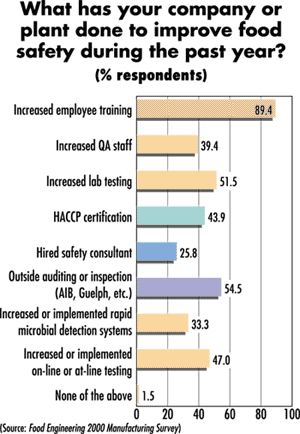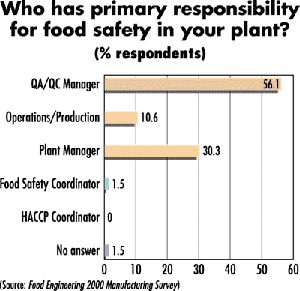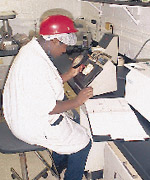
As reported earlier this year, 75 percent of respondents toFood Engineering's Best Manufacturing Practices survey (Feb., '00) have established HACCP programs in their plants. Most remarkable is the acceptance of HACCP in industry segments where it's not required: More than two-thirds of respondents in every industry segment outside of the meat, poultry and seafood industries have voluntarily implemented HACCP. Examples: 68 percent of reporting bakery plants, 79 percent of dairy plants and 100 percent of confectionery plants have HACCP plans in effect.
But as HACCP gains acceptance where it's not mandated, it's becoming more controversial where it is mandated: in the meat and poultry industries. Problems have surfaced on both the enforcement and compliance sides of the issue.

Evolving concept
HACCP is an evolving concept that continues to change and improve as food manufacturers learn more about its application, observed Dr.Timothy Freier, director of educational services for The Silliker Laboratories Group, atFood Engineering's PLANTtech 2000 Conference June 6 in Rosemont, Ill. "Just as the entire HACCP concept continues to evolve, so must our individual HACCP plans," he added.The HACCP plan must be 100-percent focused on food safety, Freier pointed out. The most important HACCP concept is that it relies on prevention rather than inspection. "It's much easier to keep all the needles out of the barn than to find the needle in the haystack," he analogized. "An ounce of prevention is worth several million pounds of recalled product."
Freier reviewed the evolution of HACCP to date:
- FDA's low-acid and acidified canned-food regulations (21 CFR 113) published in the 1970s were based on HACCP concepts, but were not called HACCP.
- The first regulation called HACCP was FDA's final rule on seafood effective December, 1997.
- USDA's final rule on Pathogen Reduction and HACCP Systems (the "MegaReg"), published in July, 1996, mandated HACCP in meat and poultry plants and was implemented in three phases (depending on plant size) from January 1998 to January 2000. The MegaReg requires reassessing the HACCP plan at least annually and whenever any changes occur that could affect the hazard analysis or alter the plan.
- In April, 1998, FDA proposed mandating HACCP for fruit and vegetable juices but at this writing has not yet published a final rule.
- In the wake of the deadly listeriosis outbreak in late 1998-early '99, FSIS in May '99 required meat/poultry plants to reassess and validate their HACCP plans for potential hazard of Listeria monocytogenes in ready-to-eat meat products. On May 5, 2000, President Clinton directed the Secretaries of Agriculture and Health & Human Services to report what "aggressive steps" they will take to halve the risk of illness and death from listeriosis by 2005. In response, USDA's Food Safety & Inspection Service (FSIS) said it will propose a rule establishing per formance standards for ready-to-eat meat products that would require plants to verify SSOPs through environmental testing for Listeria, perhaps require plants to test ready-to-eat products for Listeria; and to expand FSIS testing for Listeria.
- FDA and FSIS have conducted public meetings to gather information for reducing or eliminating risk of Salmonella enteritidis in shell eggs and egg products. Current thinking at FSIS is to require SSOPs, hazard analysis and a HACCP plan to make regulations for egg processors consistent with those for meat and poultry plants.
- FDA last November published a generic, voluntary HACCP pilot program for dairy plants based on the seven HACCP principles, the Pasteurized Milk Ordinance (PMO) and recommendations by the National Conference of Interstate Milk Shipments (NCIMS). Six dairy plants are piloting the program.
- The Codex Alimentarius Committee on Food Hygiene is involved in developing HACCP guidelines for international trade.

Compliance failures
HACCP has not yet reached its potential for reducing food-safety risks, said Freier, for several reasons:- Weak prerequisite programs. HACCP must be built on strong SSOPs, GMPs, QA programs, consumer-complaint monitoring, environmental monitoring, vendor certification and allergen management.
- Lack of upper-management commitment. Many food processors require HACCP plans of their suppliers, causing a flurry of "half-way HACCPs."
- Production rules over HACCP. "Very often, production people are in charge of HACCP and the product is released despite critical control point (CCP) violations," said Freier.
- Inclusion of issues not related to food safety. Quality components included in a HACCP plan dilute the program and confuse production workers as to what is critical and what is not.
- Not science-based. Too often, HACCP plans are based on generic models, or critical limits are based on non-similar products. But baseline studies, challenge studies and shelf-life studies are often needed to fine-tune the CCPs. Hazard analysis should include a major literature search, a thorough review of internal records, and consultation with outside experts. "In reality, hazard analysis often consists of filling out a worksheet during a brainstorming session with the HACCP team," Freier observed.
- Inadequate training. Initial and ongoing training are absolutely critical in maintaining a successful HACCP program. But OSHA training, production training, GMP training, etc. often take priority to HACCP. "Management often does not see any value in training production workers," said Freier.
- Inadequate or inefficient documentation. Examples include non-HACCP records "polluting the HACCP records;" not maintaining documents so newcomers can pick-up on and continue the sequence; inability to rapidly access data; incom plete records, which can lead to a product recall. "Always assume that any record you keep could eventually end-up in a legal trial," Freier advised.
- Lack of continuous improvement. Annual reassessments are required, but updates should occur continuously. (For an example of statistical process control applied to measuring continuous HACCP improvement, see accompanying story.)

Growing pains
Under the MegaReg, FSIS tests sample raw meat and poultry products for Salmonella, while plants sample and test their products for generic E. coli. As reported inFood Engineering's 2000 "State Of Manufacturing Report" (Sept., '00), tests conducted by FSIS on raw products from large meat and poultry plants showed significant decline in Salmonella after two years of HACCP as compared to pre-HACCP baseline studies. Tests conducted after one year on raw products from small plants also show downward trends. But as HACCP changes and evolves, it's encountering growing pains.In May, a U.S. District Court in Texas prevented FSIS from suspending inspection (effectively shutting-down the plant) at Supreme Beef Processors (Dallas) after Supreme's ground-beef operations failed three consecutive tests (and subsequently a fourth) to meet the Salmonella performance standard. The court said FSIS overstepped its authority granted by the Federal Meat Inspection Act (FMIA) because possibly-contaminated raw materials entering the plant from an FSIS-inspected slaughtering plant were not indicative of sanitary conditions within the Supreme Beef plant. "We will take whatever steps are necessary to overturn this wrong decision," said Secretary of Agriculture Dan Glickman.
Controversy surrounds the pilot HACCP-Based Inspection Models Project (HIMP), launched by FSIS in volunteer slaughtering plants one year ago. At this writing, 24 plants -- 16 chicken, five hog, three turkey -- were participating in HIMP. (No beef plants volunteered for the project.)
Under the MegaReg, FSIS inspectors continue carcass-by-carcass inspection, identifying and removing defects, defining corrective action and solving production-control problems. "This contrasts with HACCP, under which plants assume their proper responsibilities for process control, and FSIS sets performance standards and verifies that (the plant) is meeting these and other regulatory requirements," said FSIS in launching HIMP.
Under HIMP, considered by FSIS as a natural extension of HACCP, FSIS establishes performance standards for food safety and for defects not considered food-safety hazards (known as "other consumer protections," or OCPs) in chickens, hogs and turkeys. For chickens, food-safety defects include infectious diseases (septecemia and toxemia, caused by pathogens or toxins) and fecal contamination. The performance standard for these is zero. OCPs include non-infectious animal diseases, physical defects such as sores and bruises, and dressing defects such as feathers, digestive tissue, etc. Plants must revise their HACCP plans to meet the food-safety standards, and establish process-control systems to address OCPs. Plants are responsible for identifying and removing carcasses that do not meet these standards. FSIS inspectors conduct oversight inspections on-line, and verification inspections including "hands-on" inspection of product samples and verification of plant records.

But HIMP received a setback on June 30 when the U.S. Court of Appeals for the District of Columbia reversed an earlier decision by the U. S. District Court in a lawsuit brought against the Secretary of Agriculture by the American Federation of Government Employees (AFGE). The court ruled that carcass inspection by plant employees violates the FMIA and the Poultry Products Inspection Act (PPIA). "Both statutes clearly contemplate that when inspections are done, it will be federal inspectors--rather than private employees--who will make the critical determination whether a product is adulterated or unadulterated." The decision was remanded to the district court.
Emboldened by the appellate court, AFGE on August 25 filed a motion on behalf of the National Joint Council of Food Inspection Locals requesting the district court to enjoin the HIMP project. If granted, inspectors would be reassigned to fixed locations on the slaughter line and perform traditional inspection duties.
To comply with the appellate court's interpretation, FSIS on August 31 modified HIMP by assigning a federal inspector to inspect carcasses at a fixed point before the chiller, while retaining an off-line inspector to verify that plant employees are properly handling defects, and complying with the plant's HACCP plan and process-control procedures. "The agency believes that the demonstrated improvements in food safety under HIMP do not warrant the sweeping action requested by the union," said FSIS Administrator Thomas J. Billy. "The agency also believes the changes we are discussing today bring the project into compliance with statutory requirements," and began implementing these changes last month (Sept.).
Billy presented data recorded by FSIS inspectors in seven HIMP plants showing that carcasses showing infectious conditions, fecal contamination and OCP-1 (animal diseases) have been reduced from baselines. "In every category...the plants are performing better under the pilot project than plants achieved under traditional inspection," Billy pointed out. "It would be irresponsible to turn away from such marvelous gains."

'Jungle 2000'
Within a few days, however, those gains were disputed. In an obvious reference to Upton Sinclair's 1906 muckraking novel (which sparked passage of the FMIA), the whistleblowing Government Accountability Project (GAP) and Ralph Nader's Public Citizen lobby group jointly released "The Jungle 2000" report at a September 5th news conference in Washington, D.C. The report is based on a 114-question survey sent to about 2,340 FSIS HACCP inspectors, of which 451 (19 percent) responded. Respondents averaged 18.5 years as federal meat/poultry inspectors. "Jungle 2000" summarizes survey results under several categories:
- "Americans are eating dirty meat." For example, 210 inspectors reported that since HAACP there have been instances where they did not take direct action which they otherwise would have taken against contamination such as feces, vomit and metal shards.
- "Workers and inspectors fear company retaliation." Eighty-three percent of respondents reported that plant employees secretly seek their help with problems because they fear retaliation from supervisors. Forty-four percent reported plant managers arguing with their HACCP decisions. One inspector's comments were particularly cogent: "The plant owners...do not pay employees enough to keep them, and this results in high rates of turnover, which result in untrained personnel doing a job that requires an employee to recognize unsafe, unhealthy conditions or disease processes. This is why government trains the inspectors, both in classrooms and online, to have a knowledge base so that the prime mission of public safety is met."
- "Inspectors are told to 'let the system work,'" preventing them from enforcing the law as well as they could before HACCP.
- "Company management can call the shots." Fifty-nine percent said they cannot enforce the law as realistically under HACCP because government monitoring points are now based on company-created HACCP plans. Forty-five percent reported instances of contamination where the plant had no critical control point to address it. One inspector's comment was especially disturbing: "Two sets of records are being kept by the plant: one to show USDA inspectors (looks real good), and one set for their own use."
- "Inspectors audit paperwork rather than inspect meat." Eighty-four percent reported that their time spent checking company records increased fivefold while the time they spend inspecting meat declined by two-thirds under HACCP as compared to the former system. "It's a big paper chase..."
- "Inspectors favor HACCP as originally promised by USDA." More than 75 percent of respondents favor HACCP, but in conjunction with continuous bird-by-bird and carcass-by-carcass inspection.

Among their recommendations: The federal government is the appropriate institution to inspect government-approved meat; HACCP must be redesigned to include continuous carcass inspection and pre-operational sanitation inspection; inspectors must have the authority to require removal of contamination at all points throughout slaughter and processing.
Jungle 2000 and some of its respondents seem to confuse HACCP with HIMP. The MegaReg specifically states that "carcass-by-carcass inspection is a legal requirement that binds both FSIS and the industry," although the rule goes on to say that FSIS plans to examine carcass-by-carcass inspection and "determine what changes, if any, could improve the effectiveness of inspection or result in a more productive use of resources." That's where HIMP comes in.
Jungle 2000 also cites a June 21 report by USDA's Office of Inspector General (OIG) to support many of its findings, yet the OIG report specifically states that "Industry is accountable for producing safe food; government is responsible for setting food-safety standards, maintaining inspection oversight, and maintaining an enforcement program..."
On Sept. 20, Secretary of Agriculture Dan Glickman released the latest data showing continued reduction of Salmonella on meat and poultry products (see table). "The evidence is clear," said Glickman. "Our science-based, prevention-oriented food safety system is working."
Irradiation awaits packaging clearances
Irradiation is finally emerging as the manufacturing plant's final pathogen intervention for packaged meat and poultry products. Major processors including IBP, Cargill (Excel), Emmpak, Tyson, Kraft (Oscar Mayer), American Foodservice Corp. and United Food Group are evaluating Titan Corporation's SureBeam electronic pasteurization process at Titan's electron-beam plant in Sioux City, Iowa (see article this issue).As this story went to press, however, only two meat processors had introduced irradiated products to consumer markets. Reason: Many raw and processed meat products are packaged today in multilayer and barrier plastic materials yet to be cleared by FDA for irradiated applications. This is especially true for modified-atmosphere (MAP) and vacuum-packaged products.
To date, only Huisken Meats (Chandler, Minn.) and Colorado Boxed Beef Co. (CBB, Auburndale, Fla.) have introduced irradiated products to consumer markets. On May 16, Huisken launched frozen ground-beef patties irradiated at the Titan e-beam plant to Twin City markets and has since expanded distribution. On June 16, CBB introduced fresh ground-beef products gamma-irradiated by Food Technology Service (Mulberry, Fla.) to Florida markets.
21 CFR 179.45 lists packaging films accepted by FDA for irradiation via gamma technology. These are confined to materials such as non-pigmented polystyrene foam trays and single-ply polystyrene and PET films. Polymers and additives not listed in 21 CFR 179.45 include ionomers, EVOH, most nylons, adhesives, colorants, antifog agents and many more. "With the exception of a few bags, films and trays...most food-packaging materials for irradiation applications will be multi-layer, multi-constituent structures," said Dr. Charles R. Barmore, research fellow in applications development and support for Cryovac North America (Duncan, SC), at IFT 2000 June 10 in Dallas. Polymers and additives not listed in the regulation have not been determined unsafe, Barmore continued. "Rather, requests have not been submitted to FDA seeking their addition to or exemption from the regulation." A recent literature review by the National Center for Food Safety & Technology (NCFST) concluded that "irradiation at 10 kGy would not produce compounds of toxicological importance either with e-beam or photon radiation," and that "adjuvants approved for food contact will likely pose no special problems for irradiated polymers," Barmore reported.
NCFST formed an Irradiation Task Force (ITF) of packaging suppliers and converters which petitioned FDA last February to amend 179.45 to include x-ray and e-beam irradiation as equivalent to gamma ray for all polymers listed in the section. This petition is currently under review by the agency. Meanwhile, FDA temporarily allows the materials cleared for gamma irradiation to be used for e-beam and x-ray irradiation as well until Feb. 21, 2001.
NCFST is also preparing a petition to amend 179.45 to include rigid structures. The ITF identified EVOH, several nylons, ionomers and anhydride-grafted polyethylenes as the most important polymers needed to smooth introduction of commercial irradiation for packaged meats. The ITF hopes to submit a petition for these early next year, said the center's Dr. George Sadler.
Meanwhile, current regulatory limitations will delay the use of irradiation for a significant number of retail products, Barmore observed at IFT. FDA approval of the NCFST source-equivalency petition is critical if irradiation is to be more widely applied to meat/poultry products, he added, while "remedying the limitations of available polymers will be a lengthy and expensive process."
Why HACCP Has Not Yet Reached Full Potential
Weak prerequisite programs (GMPs, SSOPs, etc.)- Lack of top-management commitment
- Production still rules over HACCP
- Inclusion of non-food safety issues
- Not science-based
- Weak CCP validations
- Hazard analyses weak to nonexistent
- Inadequate training
- Inadequate or insufficient documentation
- Lack of continuous improvement

Sidebar: Butterball integrates SPC with HACCP
By: Syed Ajaz Hussain, PhD, Director, Technical Services, ConAgra Refrigerated Prepared Foods; John G. Surak, PhD, Professor of Food Science, Clemson University; Jeffery L. Cawley, Vice President, Northwest Analytical, Inc.Traditional microbiological tests are ineffective in providing the necessary real-time information required for effective HACCP programs. But these microbiological analyses can be used to verify the effectiveness of HACCP.
The Butterball Turkey Co., a unit of ConAgra Refrigerated Prepared Foods, applies statistical process control (SPC) to verify and record continuous improvement in reducing generic E. coli on turkey carcasses, thereby continuously improving its performance compared to HACCP specifications.
Control charts, produced by NWA Quality Analyst SPC software, identify trends and help operators adjust the process to reduce risk of defective product. When a manufacturing process is controlled to the point where output measurements are predictable and vary within statistically-defined upper and lower control-chart limits, the process is considered stable and in statistical control.
In Butterball plants, turkey carcasses are aseptically sampled and inspected for generic E. coli after the drip line at the end of the chilling system. Until recently, carcasses were analyzed using the whole-bird rinse technique: Each sample was placed in a plastic bag containing phosphate diluent, then rinsed inside and out with a manual rocking motion of 30 cycles for about one minute. Rinse water was collected and plated using the AOAC 17.3.04 method. Results were reported as colony-forming units per milliliter (cfu/mL). This method of sampling has since been replaced by a swab procedure, but the results remain applicable for process control.
Early in January, 1997, statistical analysis confirmed that the turkey process was stable and capable of meeting internally-established specifications for generic E. coli. Toward the end of January, however, a major manufacturing change inadvertently caused a slight increase in E. coli levels, although levels were still below the established upper-specification limit. A corrective-action team consisting of plant operations, quality assurance, maintenance and procurement people was formed, and applied SPC to identify and eliminate the root cause of the problem. The team then recommended and implemented process improvements including:
- Improved handling of birds from the breeder. Procurement people worked closely with producers to improve conditions of birds entering the plant.
- Addition of new chlorinated spray cabinets to the process line, following the pickers.
- Upgrading first and final wash cabinets with a new chlorinating system and higher water pressures, along with controls to monitor and verify chlorine levels and water pressures.
- Additional inspectors stationed between the final wash and the chilling system.
By linking HACCP control points and quality-improvement (QI) teams to SPC, Butterball has developed a highly capable manufacturing process. Should a process change or any other factor affect the system, a QI team can identify the root cause of the problem and take corrective or preventive action. Additionally, this strategy increases employee involvement, awareness, attention to detail and motivation while improving product quality and productivity.
